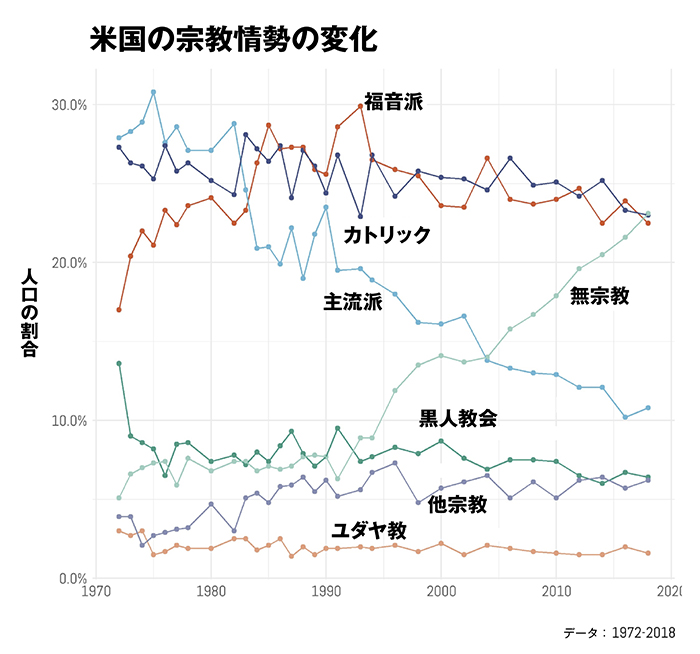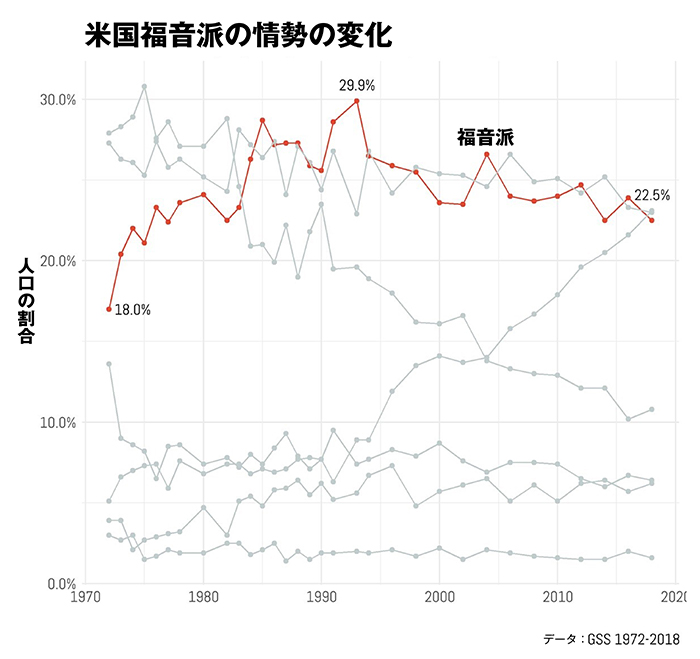米国で最も長期にわたって宗教を調査してきた機関の一つ、「総合的社会調査」(GSS)による2年ぶりの最新結果によると、無宗教者が成長する中でも、米国の福音派は人口の4分の1弱の割合で安定している。また、主流派は意外な増加傾向があったと報告された。
Evangelicals in the United States are holding steady at just under a quarter of the population, according to the latest biennial figures from the General Social Survey (GSS), one of the longest-running measures of religion in America.
日々目まぐるしく変わるニュースや政治動向の中で、GSSのような長期的な調査は、米国の宗教情勢がどう変化しているか、その最もいい全体像を社会科学者に示してきた。この調査は46年以上、同じ方法で、あらゆる宗教について行われている。そして、長年にわたる信仰と行動の傾向について、権威ある、信頼性の置ける基準を提供してきた。
Despite the quick pace of news and week-to-week political polling, it’s longitudinal tools like the GSS that give social scientists the best big-picture views of how America’s religious landscape is shifting. The survey has asked about religious affiliation in the same way for more than 46 years, offering authorative, reliable measures of trends in belief and behavior over time.
「宗教科学研究ジャーナル」の編集者トビン・グラントは次のように指摘する。「宗教の変化には時間がかかる。どの宗教も、急速に信徒が増えたり減ったりすることはない」(「無宗教」は、どの宗教にも関わらない人なので、例外だ。他の宗教に比べ、急速な人数増加が見られるのは、複数の信仰グループから流入しているため)
As Tobin Grant, editor of the Journal for the Scientific Study of Religion, pointed out: “Changes in religion are slow. No group gains or loses quickly.” (The “nones,” a popular term for the religiously unaffiliated, being an exception—gaining faster than other affiliations tend to because they pull from multiple faith groups.)

この2018年のGSSの結果から、福音派は過去10年間、人口の約22・5%前後を推移しているが、現在は無宗教が23・1%まで増えたことが明らかになった。(比較のため、ピュー研究所の2014年の宗教情勢調査では、福音派25・4%、無宗教22・8%)
That’s mostly what the 2018 GSS results show us. Evangelicals—grouped in this survey by church affiliation—continue to make up around 22.5 percent of the population as they have for much of the past decade, while the nones, now up to 23.1 percent themselves, keep growing. (For comparison, the Pew Research Center’s 2014 Religious Landscape Survey put evangelicals at 25.4 percent and the religious nones at 22.8 percent.)

福音派の人口は、24・7%となった2012年を除き、過去10年間で米国人口の22・5%から24%の間に位置している。安定して見えるが、福音派の中で「変化がない」という意味ではない。どの宗教グループにも「変動」は常に起こっている。死亡や他教派への転会によってそのグループを離れるし、信仰が成長したり、大人になって改宗したりして新しいメンバーに加わる。
Other than one outlier—a slight peak of 24.7 percent in 2012—evangelicals have ranged from 22.5 percent to 24 percent of the US population over the past 10 years. Still, this steadiness doesn’t mean “no change” among the evangelical population. There is always a “churn” occurring within any religious group. People leave the group because of death or defection, while new members either grow up in the faith or convert as adults.
福音派の割合が過去10年間で比較的安定しているという事実は、無宗教の増加が続いていることを考えると驚異的だ。福音派は少なくとも今のところ、離れてしまった信徒と同じ数の新しいクリスチャンを獲得していることになる。最近の調査によると、ボーンアゲイン(新生した)クリスチャンのうち、2010年から14年までの間に95%近くがそのまま留まったのに対し、クリスチャンと言いながらボーンアゲイン・クリスチャンではない人は85%だった。さらに、「特になし」という回答者の大部分は、福音派の教会に戻っている。
The fact that evangelicals’ share of the population remains relatively stable over the last decade is striking given the continued rise of the nones. Evangelicals have been able to replace losses as fast as they are occurring, at least for now. Recent survey evidence has found that nearly 95 percent of born-again Christians stayed that way from 2010 to 2014, compared to just 85 percent of those who said that they were Protestant but not born-again. In addition, a significant portion of “nothing in particular” respondents do make their way back to evangelical churches.
2016年の前回結果から18年の最新のGSSまでの間に、福音派信徒数は約1・4%減少した。これは大きな変化と呼ぶには至らず、調査の誤差の範囲内だ。長期的な傾向を見ると、福音派は1972年以来、約5%増加しているが、現在は、93年に29・9%を記録した時より無宗教者数が増えてきたのに比例して7・5%低くなっている。
Between the previous GSS in 2016 to the most recent in 2018, evangelicals dropped about 1.4 percent—not enough to amount to a significant change, and within the survey’s margin of error. When you look at the long-range trends, evangelicals have increased their share of the population by about 5 percentage points since 1972, though they’re currently 7.5 percentage points lower than their highest share of the US population: 29.9 percent in 1993, just as the nones began their upswing.
福音派にとって今後の課題は、多様な人々の獲得だろう。2018年には、白人は米国人口の72・4%を占めていたのに対し、福音派の81%は白人だった。ちなみに、25歳未満の米国人10人のうち4人以上が有色人種だ。福音派が将来の世代の損失を相殺し続けるためには、人種的に多様になる必要がある。(後編に続く)
One challenge for evangelicals ahead will be simple demography. In 2018, 81 percent of evangelicals were white, compared to 72.4 percent of the population overall. More than 4 in 10 Americans under 25 are people of color. For evangelicals to keep offsetting losses in future generations, they will need to become more racially diverse.
「クリスチャニティー・トゥデイ」(Christianity Today)は、1956年に伝道者ビリー・グラハムと編集長カール・ヘンリーにより創刊された、クリスチャンのための定期刊行物。96年、ウェブサイトが開設されて記事掲載が始められた。雑誌は今、500万以上のクリスチャン指導者に毎月届けられ、オンラインの購読者は1000万に上る。
関連



























